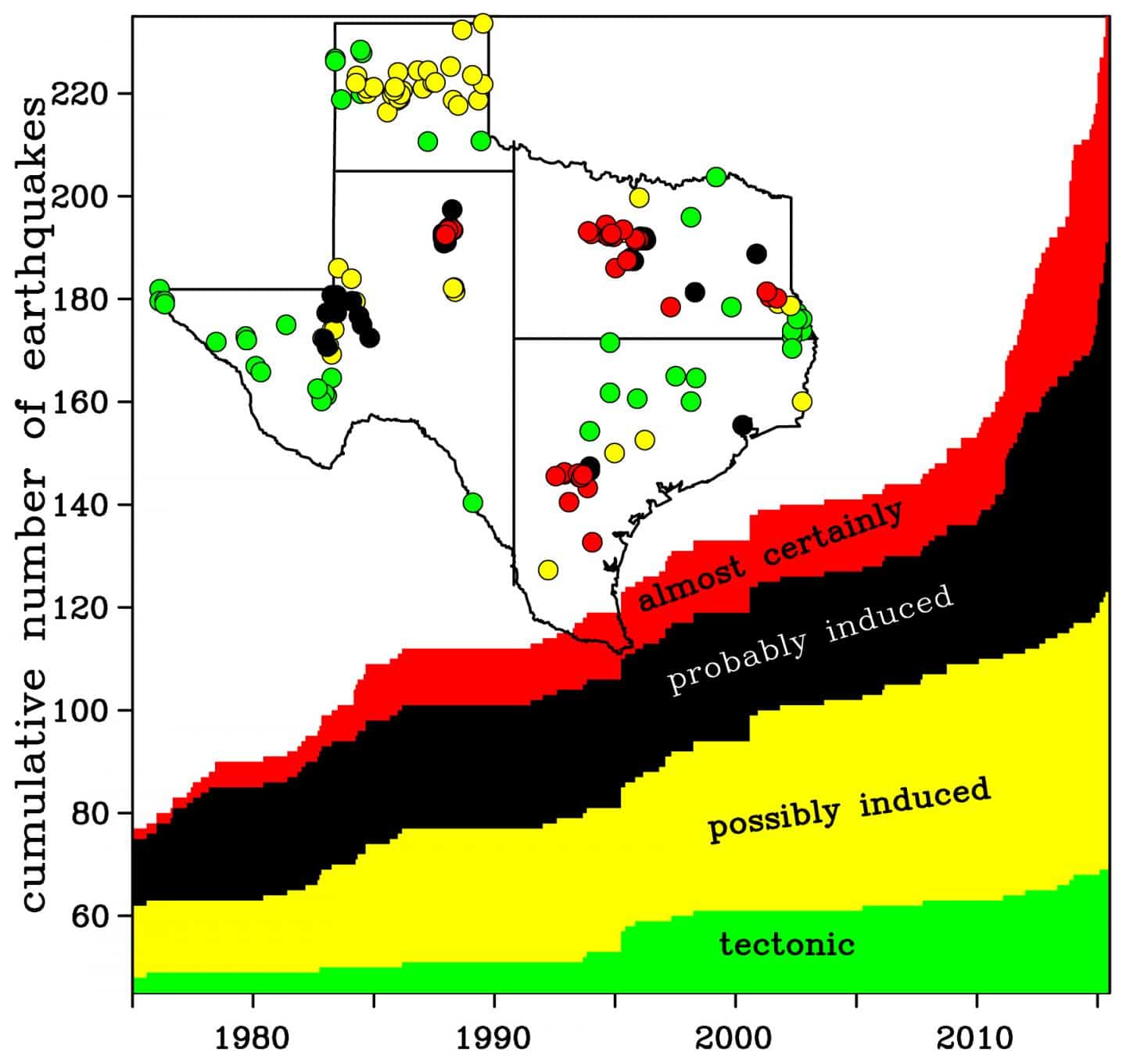If you’ve felt an earthquake in Texas at any point over the last four decades, odds are that quake wasn’t naturally occurring, but was caused by oil and gas industry activities, according to a newly published scientific report.
Just 13 percent of Texas earthquakes larger than magnitude 3 since 1975 were the result of natural causes alone, according to scientists from the University of Texas who published their peer-reviewed paper in the journal Seismological Research Letters.
In recent years, fracking wastewater injection wells have become the primary cause of tremblors in the state, the report adds.
And it’s not simply a modern phenomenon, the researchers found. In fact, so-called induced earthquakes, or those caused by human activities, date all the way back to the 1920’s.
“The record clearly demonstrates that induced earthquakes have been broadly distributed in several different geographic parts of Texas over the last 90 years,” the study concludes.
“The public thinks these started in 2008, but nothing could be further from the truth,” Cliff Frohlich, a senior research scientist at the University of Texas at Austin and the lead author of the new study, told Claims Journal, an insurance industry publication.
While wastewater injection in Oklahoma has drawn national attention for the earthquake swarms that have resulted — making Oklahoma more earthquake-prone than California in recent years — the industry’s impacts in Texas have gone less-noticed, though the numbers are striking.
Between 1975 and 2015, Texas was shaken by 162 reported earthquakes registering over 3.0 on the Richter scale. Forty-two of those quakes were “almost certainly” caused by the drilling industry, the researchers concluded, and an additional 53 were “probably” the result of oil and gas activities – or roughly 60 percent of the total. Another 28 percent were “possibly” connected to oil and gas activities, the researchers said, explaining that a lack of detailed information about many quakes made definitive conclusions more difficult.
In other words, there is good reason to suspect that nearly 90 percent of earthquakes in Texas over the past 40 years were industry-linked.
And as the shale drilling boom has expanded, the number of quakes shaking Texas has risen dramatically, the scientists added. Over the last eight years, Texas went from experiencing two or three earthquakes a year to twelve — with fracking wastewater disposal the likely culprit.
So while the drilling industry has been causing quakes since at least 1925, the problem has become particular acute in recent years.
After reviewing the paper’s findings, other scientists agreed that the rise in earthquakes showed that the industry’s impacts in recent years have intensified.
“By having this all in one place, it becomes quite obvious that we’re observing something quite different from what we had been observing 10 years previously,” Geoffrey Abers, a Cornell professor specializing in seismology, geology and tectonophysics and who was not part of the study, told the Christian Science Monitor.
Prof. Frolich and his colleagues pulled data from court filings, scientific papers, and oil and gas industry records to collect as much information as possible about the history of earthquakes in Texas, where the drilling of the first gusher in the Spindletop oil field in 1901 launched the transformation of the Gulf Coast region into one of the world’s largest oil producers.
In Baytown, Texas, just outside of Houston, the Goose Creek oilfield pumped so much oil from underground between 1903 and 1925 that ground level fell by roughly a meter, accompanied by quakes that “’shook the houses, displaced dishes, spilled water, and disturbed the inhabitants generally’,” the study says. As the ground level dropped, nearby waters from the Gulf of Mexico flooded in, submerging parts of the oilfield. This prompted the state of Texas to attempt to seize the oil rights to Goose Creek, arguing that territory off the coast belonged to the state and not individuals. Humble Oil – a predecessor of ExxonMobil – argued in court that because their drilling had caused the earthquakes, the ground subsidence was an “act of man,” rather than nature – and the courts agreed, ruling that the company had caused the earthquakes.
“Thus, one notable feature of the Goose Creek earthquakes is that there is a court ruling and a 90-year-old precedent supporting the assertion that oil and gas activities induce land subsidence and accompanying earthquakes in Texas,” the new study says.
That’s a very different type of conclusion than the oil industry – and specifically ExxonMobil itself – has advanced for earthquakes that have struck the state in more recent years. “It looks to me like we’re in a period of natural tectonism,” Andree Griffin, vice president for geology and geophysics at XTO, an ExxonMobil subsidiary, testified before the Texas Railroad Commission, the state’s oil and gas regulator, last year during a hearing over a swarm of roughly 20 earthquakes in 2013 and 2014 which XTO denied it had caused.
The energy giant remains the subject of a separate probe by state attorneys general in 17 states over its early knowledge of scientific evidence showing that oil and gas emissions were changing the climate, and the company’s subsequent, potentially fraudulent, denial of that science.
Across the U.S., the evidence has piled up connecting the oil and gas industry to earthquakes. In California, for example, a 2005 earthquake swarm was caused by the oil and gas industry, according to a peer-reviewed study published in February. Oklahoma went from having two earthquakes over magnitude 3.0 a year prior to 2009 to 907 such quakes last year, with oil and gas activities the cause, 60 Minutes reported in a major expose earlier this month. And in March, the United State Geological Survey (USGS) warned that over 7 million people now live in areas endangered by human-caused earthquakes, with those at the highest risk including not only residents of Texas and Oklahoma, but also Kansas, Colorado, New Mexico and Arkansas.
Last year, the Texas state government budgeted $4.47 million to install 22 more seismic monitoring stations, bringing the state’s total to 39, in the hopes of collecting more data about earthquakes, both natural and induced.
But many environmental and community groups say that monitoring fails to go far enough to protect people and property. Earlier this month, a coalition of environmental groups filed a federal lawsuit demanding that the Environmental Protection Agency update its rules surrounding how oilfield wastewater is disposed under the nation’s hazardous waste handling laws, citing in part the connection between wastewater injection and induced earthquakes.
Around the same time, the Center for Biological Diversity asked the federal Bureau of Land Management to drop oil and gas drilling leases for roughly 2,300 acres of land in Oklahoma and Kansas because of earthquake risks.
For the time being most of the earthquakes caused by the oil industry have been relatively minor – in no small part because for decades, the quakes took place in lightly populated areas like Texas deserts.
“If these kinds of things cause huge earthquakes, Texas would be famous for huge earthquakes that rock the state all the time,” Prof. Frohlich told a Texas Fox News affiliate, adding that if a magnitude 5.0 quake struck Dallas, it would do far more financial damage than even one more than ten times that size in isolated parts of West Texas.
But already wastewater injection has been tied to quakes as large as the magnitude 5.7 earthquake that shook Prague, OK in 2013 – big enough to destroy 14 homes and be felt as far away as Wisconsin.
Federal researchers say that the largest induced earthquakes are likely to top out at roughly 6.0 on the Richter scale. “But we can’t rule out quakes of magnitude 7 and above,” Mark Petersen, head of the National Seismic Hazard Mapping Project, told Scientific American.
And the new research shows that it’s not just wastewater injection, but a broad range of oil and gas industry activities that have caused earthquakes in the U.S.
While ground subsidence caused some of the earliest known industry-connected quakes, later in the 20th century, as production from aging Texas wells began to slow, the oil industry began pumping water down into oil reservoirs to help push oil to the surface, a technique called waterflooding – and again, the ground began to shake. In West Texas, for example, quakes as strong as magnitude 4.6 rattled the state between 1974 and 1982 – which the researchers said was “almost certainly” the result of waterflooding in the area.
This means, Prof. Frolich said, that it wasn’t possible to point the finger at just one or two practices to prevent the industry from causing more earthquakes in the future.
“I think we were all looking for what I call the silver bullet, supposing we can find out what kinds of practices were causing the induced earthquakes, to advise companies or regulators,” he said. “But that silver bullet isn’t here.”
Photo Credit: Graphic by Cliff Frohlich/ University of Texas at Austin
Subscribe to our newsletter
Stay up to date with DeSmog news and alerts







